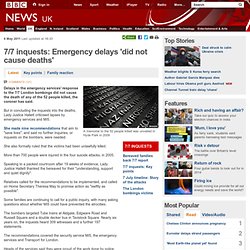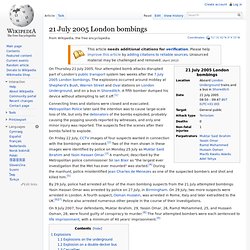

University of Huddersfield. 7th July London bombings: Four years after 7/7, a never before seen picture inside the Russell Square train. By Sam Greenhill Updated: 10:36 GMT, 8 July 2009 Inching through debris and choking heat, police forensic officers comb the wreckage of one of the 7/7 tube trains in this never-before-seen picture.

Hunting for particles of evidence, they toiled in searing temperatures in the Underground carriages where suicide bomber Jermaine Lindsay blew up 26 innocent people four years ago yesterday. Warped and blackened by the blast, this is the Piccadilly Line carriage where Jermaine Lindsay's bomb detonated at Russell Square station. A forensics officer in white rubber gloves inches his way along the floor - itself sheared away in the blast, exposing metal beams - searching for the smallest of clues. Interactive: 7/7 inquest - the victims' testimony. London bombings toll rises to 37. A series of bomb attacks on London's transport network has killed more than 30 people and injured about 700 others.

Three explosions on the Underground left 35 dead and two died in a blast on a double decker bus. Foreign Secretary Jack Straw said the bombings had "the hallmarks of an al-Qaeda-related attack". Prime Minister Tony Blair promised the "most intense police and security service action to make sure we bring those responsible to justice".
7/7 inquests: Emergency delays 'did not cause deaths' 6 May 2011Last updated at 16:33.

Response to the 2005 London bombings. The 7 July 2005 London bombings were a series of suicide attacks carried out by homegrown terrorists on London's public transport network during the morning rush hour.

The bombings, three on the London Underground and one on a bus, killed 52 people and prompted a massive response from the emergency services, and in the immediate aftermath the almost-complete shut down of the city's transport system. Over the following hours and days there were several security alerts throughout the United Kingdom, and in some foreign cities. Emergency services and the London bombings. According to the Strategic Emergency Plan, a thick, calmly bureaucratic document published by a government body called the London Resilience Partnership, the capital's response to a major incident is a matter of strict hierarchy.

Upon being alerted to "an event or situation which threatens serious damage to human welfare," senior figures in the emergency services, the NHS, the military, the government and transport are summoned to New Scotland Yard, behind St James's Park tube station. (They are then transferred to a secret location, which becomes known as the Strategic Command Centre.) Once in place, they form the Gold Coordinating Committee, which devises a response to the crisis, their commands cascading down the levels of seniority to the police officers, ambulance crews and firefighters on the ground.
All these things did eventually happen two weeks ago, after suicide bombers detonated explosives on a London bus and three tube trains, killing 56 people. University of Huddersfield. LONDON ATTACKS. Five men accused of plotting to murder passengers on London's transport network on 21 July 2005 are set to face trial in January 2007: Yassin Hassan Omar, 24 Charged with:

Communication failures hampered London bombing rescues. London bombings. 7 July 2005 London bombings. The 7 July 2005 London bombings (often referred to as 7/7) were a series of coordinated suicide attacks in central London, which targeted civilians using the public transport system during the morning rush hour.

On the morning of Thursday, 7 July 2005, four Islamist men detonated four bombs—three in quick succession aboard London Underground trains across the city and, later, a fourth on a double-decker bus in Tavistock Square. As well as the four bombers, 52 civilians were killed and over 700 more were injured in the attacks, which became the United Kingdom's worst terrorist incident since the 1988 Lockerbie bombing as well as the country's first ever suicide attack. The explosions were caused by homemade organic peroxide–based devices packed into rucksacks. The bombings were followed two weeks later by a series of attempted attacks which failed to cause injury or damage. Attacks[edit] London Underground[edit] Tavistock Square bus[edit] 21 July 2005 London bombings. Connecting lines and stations were closed and evacuated.

Metropolitan Police later said the intention was to cause large-scale loss of life, but only the detonators of the bombs exploded, probably causing the popping sounds reported by witnesses, and only one minor injury was reported. The suspects fled the scenes after their bombs failed to explode. On Friday 22 July, CCTV images of four suspects wanted in connection with the bombings were released.[2] Two of the men shown in these images were identified by police on Monday 25 July as Muktar Said Ibrahim and Yasin Hassan Omar.[3] A manhunt, described by the Metropolitan police commissioner Sir Ian Blair as "the largest ever investigation that the Met has ever mounted" was started.[4] During the manhunt, police misidentified Jean Charles de Menezes as one of the suspected bombers and shot and killed him.[5]
London bombing report says failure to stop attacks due to lack of resources and failure to anticipate homegrown Jihadis - Militant Islam Monitor - Militant Islam Monitor. Militant Islam Monitor > Articles > London bombing report says failure to stop attacks due to lack of resources and failure to anticipate homegrown Jihadis May 11, 2006 Two 7/7 bombers were under surveillance David Batty and agenciesThursday May 11, 2006.

Communication failures hampered London bombing rescues. A report on the July 7, 2005, London bombings has said the lack of a digital radio network hampered the efforts of emergency service rescue teams.

Noting that rescue teams were unable to communicate properly between the sites of the explosions underground, colleagues at ground level and control rooms, the London Assembly's July 7 Review Committee report said it is "unacceptable" that the emergency services are still not able to communicate by radio when they are underground, 18 years after the official inquiry into a fire at King's Cross station recommended action to address the problem.